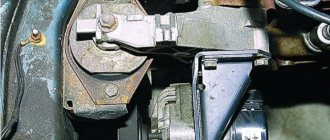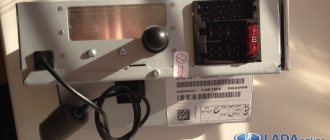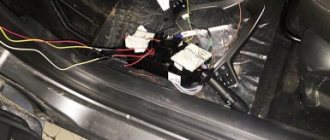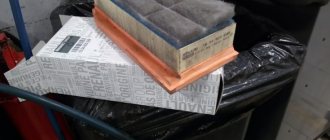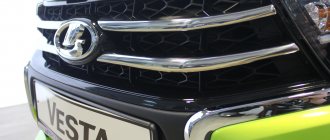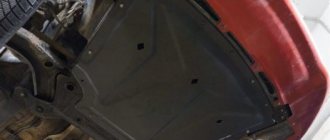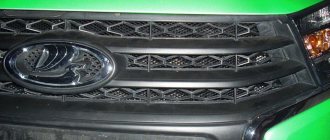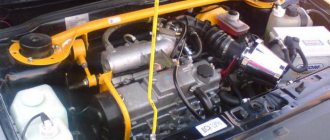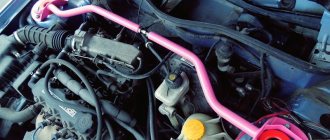The power unit (motor with gearbox) is suspended on supports, which are also called engine mounts. Strong vibrations transmitted from the engine to the body indicate wear on these rubber parts. To prevent this negative effect from occurring, it is recommended to replace the engine mounts as they wear out.
This manual covers the replacement of VAZ 21129, VAZ 21179 and HR16 engine mounts installed on the Lada Vesta and XRAY models.
Replacing the left engine mount
The left support is attached to the side member with four bolts. The support is attached to the gearbox bracket with two bolts. The bracket itself is secured to the gearbox housing with three bolts. Access to the left airbag is blocked by the battery shelf, engine crankcase protection and air filter bracket; these parts will need to be removed.
Place a jack under the gearbox and lift it slightly, unloading the left support. Then:
- Unscrew the four bolts securing the support to the body using a 16mm wrench (No. 2);
- Unscrew the two bolts securing the support to the gearbox bracket (No. 1), 18mm wrench.
- Remove the left engine mount.
Installation of the new support is carried out in the reverse order. We tighten the bolts (No. 1) from 90-120 Nm, and the bolts (No. 2) - 53-71 Nm.
Looking for reasons
Alarming sounds while driving or at rest with the engine running is a problem that worries more than one thousand drivers. Most often we can hear them during idle, when they are usually quite rhythmic and periodic. They sound like a tapping sound that becomes more frequent and seems to disappear as the speed increases. In other cases, on the contrary, they make themselves felt during acceleration, braking or driving over uneven surfaces and potholes. In these cases, however, these sounds tend to be less periodic and often sound much louder.
We bring to your attention a video instruction that shows how to make a very quiet exhaust in a car:
Can we calmly continue such trips and ignore alarming sounds? Of course not. There may be different, more or less serious reasons behind these sounds of impacts from under the car. The previously mentioned situations in which they appear with a high degree of probability indicate an exhaust system or a problem with the suspension or chassis.
The drive unit is flexibly attached to the body, that is, using a so-called rubber cushion, and therefore the exhaust system must also be connected to the body. Elastic suspensions are elastic elements at the mounting points of the exhaust system. Unfortunately, they lose their properties due to use, aging rubber or mechanical damage. Their damage affects the displacement of the exhaust system by tens or even hundreds of millimeters, which affects not only the sound of the exhaust, but also the integrity of the body. These impacts may additionally be the result of damage to the engine mount, and this, as we all understand, is no longer a joke.
Professional auto mechanics and fuel system specialists recommend servicing your mufflers in specialized workshops or services, since independent and incorrectly performed repairs of exhaust ducts can contribute to the deterioration of the exhaust system or only partial muffling without thorough repairs. When replacing damaged rubber exhaust fasteners, it is best to replace them with new ones, even with those fasteners that may appear new. Complete replacement of such inexpensive components ensures that the mounting points have the same elasticity and at the same time improves their durability, meaning the driver can rest easy.
Source
Replacing the right engine mount
The right cushion is attached to the side member with two bolts, and three bolts to the engine. Remove the engine splash guard and raise the right side of the engine using a jack. Then:
- Unscrew the two bolts (No. 2) securing the support to the body, the key is “16”;
- Unscrew the two bolts (No. 1) securing the support to the engine bracket, TORX E12 wrench;
- Remove the right engine mount.
Installation in reverse order, tighten the bolts to 53-71 Nm. The right engine mount HR16 has a different design:
Tuning - does it take place?
Of course it does! For example, today many cars undergo chip tuning (changes in the software of the computer that controls the engine). At the same time, it is recommended to upgrade the exhaust system.
Among such upgrades, the following means are often used: turning off the USR valve (it is responsible for exhaust gas recirculation), removing the catalyst.
As I already said, all this has a positive effect on increasing the car’s power, but it also has a negative effect on the environment. Here you must make your own choice, but keep in mind that if there is a purpose/probability of traveling/moving to Europe, you may not pass the test for the level of harmful substances in the exhaust.
Replacing the rear additional engine mount
To reduce vibrations of the power unit, prevent knocking, and also reduce vibrations on the body, a rear support is additionally installed below. You can check the pillow by rocking it in the longitudinal and transverse directions.
Remove the engine protection, and then:
- Unscrew the nut (No. 7) using a 18mm wrench, holding the bolt from turning;
- Remove the bolt (No. 1) using the same tools;
- Loosen the bolt (No. 2);
- Remove the bolt and remove the rear support.
When installing, tighten the bolts to 90-120 Nm.
H4M rear engine mount:
Read on our website other instructions for repair and maintenance of Lada Vesta or XRAY.
Share on social networks:
Found an error? Select it and press Ctrl+Enter..
The pillow, also known as the Lada Vesta engine support, is a kind of stabilizer against detonation. Vesta car parts come in three types: left, right, rear additional - price from 1,400 rubles. The parts have a separate article number. Malfunctions: the main malfunction is a knocking sound from the support, usually knocking on the left. The left pillow is reinforced. It is important to adjust the engine mount correctly. During engine operation, useful energy is generated, which is used to set the Lada Vesta car in motion. The movement of the “insides” of the motor causes it to begin to create vibration. To “dampen” engine vibration, they place them on supports, which perform several more functions:
- increase sound insulation of the engine compartment;
- protect other parts and assemblies from damage;
- stabilize the position of the motor as much as possible (if the amplitude of movement of the motor constantly increases, this will lead to wear of the connections);
- protect the engine from the negative influence of the external environment (when the car passes obstacles, the suspension does not completely dampen rolling, and the struts act as additional shock absorbers).
Diagnostic methods
Signs of wear on engine mounts
- Engine vibration at idle.
- Extraneous knocks while driving, felt in the engine compartment or under the gearbox.
- Jerks during dynamic acceleration of the car.
- Knocks in the engine compartment when starting or stopping the engine.
- Difficulty shifting gears.
On cars with hydraulic supports, in addition, acceleration dynamics may deteriorate. Visually, faulty airbags can be identified by delamination and ruptures of rubber dampers or breakage of aluminum brackets. An experienced specialist can also visually identify a sagging pillow by how severely its damper is deformed.
Types of pillows
Despite the variety of design options, the general purpose of the cushions is to act as an engine mount, i.e. dampen vibrations and vibrations of the power unit. The role of an engine damper is usually played by rubber (sometimes in interaction with the hydraulic properties of the oil), absorbing shocks and vibration, while preventing displacement of the power unit.
As an example, we can take the motor mount on the Niva. It is a rubber cylinder with plates with threaded rods welded to it. The left and right engine mounts are absolutely identical, the third, which supports the gearbox, has a slightly different appearance and is mounted on a crossbar mounted on the bottom of the car.
The dimensions of the supports and their attachment points are designed in such a way as to prevent displacement of the power unit, while the weight of the engine compresses the cushion, and is distributed in such a way that rupture of the rubber due to its shear deformation is practically eliminated. In a similar way, the engine, also located longitudinally to the axis of the car, was installed on " Volgakh".
But with a transverse engine arrangement, it is somewhat more difficult to balance it, due to the design of the power unit as a whole. Therefore, the supports most often take the form of suspension arms, which have silent blocks as an engine damper, as on the additional supports of the VAZ 2112: This design of supports is also sometimes caused by the need to support the points of the engines most distant from the body, which after modernization have acquired a large mass.
The use of additional supports allows you to install heavier engines without significant changes to the design of the car. The most typical method for relatively small power units is the method of “hanging” them, as on 2108 -09. The engine assembly with gearbox has three mounting points:
- left engine mount;
- rear (lower) engine mount.
How do engine mounts work?
The cushions work similarly to the silent blocks of the suspension arms, that is, they twist the rubber. Therefore, on cars driven primarily on bad roads, because... such supports turn out to be unreliable - the rubber delaminates. More compact cars, which are relatively heavy (in relation to the total weight of the car), are suspended somewhat differently - the rubber damper in them works in compression-tension, which increases its service life.
Hydraulic (or hydromechanical) engine mounts differ from conventional ones in that they have variable stiffness. This is achieved by taking vacuum from the engine. When a certain number of revolutions is reached, the valve separating the support chambers closes.
DETAILS: Changing the oil in Volkswagen Golf 5. Changing the oil of Volkswagen Golf 5 with your own hands
As a result, the liquid (antifreeze), which previously flowed from chamber to chamber, begins to play the role of an elastic element. Externally, such supports differ mainly in the presence of a fitting for connecting a vacuum hose and cable. Such cushions are intended to dampen vibrations from the motor, the bulk of which “lies” on other supports.
So, the owner believes that the engine mount has failed. The symptoms of the malfunction were confirmed. Next, you need to check the condition of the supports. In order to ensure the integrity of these parts, you will need a jack and any supports - wood stumps, pallets, tires.
Anything will do. It is also advisable to prepare a crowbar or a thick stick. Let's look at how to determine if an engine mount is faulty. To do this, it is recommended to place the car on the most flat surface possible. Then the car needs to be lifted using a jack, then a prepared support should be installed under the engine. It could be a log or something else. It's better to remove the jack.
Standard support left, right, rear – article number and price
The entire engine support system, called the suspension of the Lada Vesta car, consists of 14 parts, for each of which it is worth giving brief information:
- Right engine mount assembly. Article: 8450030109. Price: from 1800 rubles.
- Engine mounting rod with cushion and silent block assembly. Catalog number: 112381035R. Cost: from 700 rubles.
- Rear engine mount bracket. Article: 8450006293. Price: from 3,900 rubles.
- Reinforcement bracket for rear engine mount. Article: 8450030214. Price: from 70 rubles.
- Left engine mount cushion assembly. Article number: 8450006299. Cost: from 1000 rubles.
- Left rear eye for lifting the engine. Serial number: 8450008699. Price: from 600 rubles.
- Bolt M10-1.5-35 10-9 SA3GS. Article: 7703602240. Cost: from 300 rubles.
- Nut M10x1.25. Article: 8450001014. Cost: from 30 rubles.
- Lower right engine mount bolt. Catalog number: 8450007980. Cost: from 60 rubles.
- Upper right engine mount bolt. Catalog number: 8450008999. Cost: from 70 rubles.
- Bolt M12-1.75-90 10-9 SA3GS (for bracket amplifier). Article: 7703602269. Price: from 600 rubles.
- Hex nut with flange M12x175. Article: 7703033210. Price: from 350 rubles.
- Rear engine mount bracket mounting bolt. Catalog number: 8450007985 (the lower bolt is numbered 8450007986). Cost: from 300 rubles.
- Bolt M10X1, 25X53 TORX E Article: 8450008989. Price: from 30 rubles.
- An additional engine mount for the Lada Vesta is sold under number 8450031975 and costs from 1,400 rubles.
How to check engine mounts
The first sign of a strut malfunction is a knocking sound coming from the engine compartment. To pre-confirm this “diagnosis”, check for the following signs:
- A hum is heard in the cabin when driving at high speeds.
- When starting the Lada Vesta engine when cold, metallic tapping is heard in the cabin and strong vibration is felt.
- When accelerating sharply or braking sharply, knocking noises are heard from under the hood.
- A knocking sound from the left engine mount of the Lada Vesta is less common, but the final conclusion can be made by visually inspecting the cushions. A good rubber-metal part should be completely free of damage, so that the rubber does not make a knock when it comes into contact with metal - this way it does not absorb shocks.
- Rock the engine and then press on each corner to identify the worn pad that needs to be replaced. Wait until it cools down before touching the motor.
The knocking sound of the upper engine mount on Vesta is common
It is important to point out the knocking of the Lada Vesta engine mount, which carries a greater load than the other two - this is the upper (or lower) cushion. It is located in the center and does not dampen the vibrations that come to the left or right edge of it, which is why it quickly becomes loose. The design can be modernized by adding a special pillow for the sports version.
Hydromount from BMW
1. First version Stage 1
Engine mount 2495601 from BMW 3 (E46) was taken as a basis. The price is about 2800 rubles.
The peculiarity of the support is that it is hydraulic (the design uses not only metal and rubber, but also oil).
a) at idle, soft support: b) in motion, hard support: 1 – lower (expansion) chamber; 2 – throttling channel; 3 – upper (working) chamber; 4 – movable membrane; 5 – hydraulic support housing; 6 – damping fluid channel.
The difference between a hydraulic and standard support is demonstrated in the video:
The weight of the pillow is 1.76 kg.
5300 rub. (the LEMFORDER 2495601 support itself costs about 2800 rubles).
2. Modified version of Stage 2.
The hydraulic mount itself is essentially the same thing with the addition of a guitar of the same manufacturer. Due to this, we managed to save some money, so the price increased only for the silent block itself.
Silent block from jikiu be21058, there are no analogues.
Manufacturers and prices of analogues
The cushions for Lada Vesta engines are considered by owners to be not particularly reliable and are even being modified to increase the effect of vibration absorption.
The TuningProsto studio is developing improved spare parts from AvtoVAZ, including a recent development - an engine mount. Their price will be on average 3,000 rubles, orders are still being accepted. The tests were successful, and on a car dealer's car intended for a test drive - the car is used very often.
Otherwise, there are no special attempts to create analogues, because the “craftsmen” have already drawn the attention of Vest owners to two modification options:
- Came from Renault owners. It is necessary to create for each problematic pillow a metal plate 80 mm long, 38 mm wide and two grooves on the sides measuring 23 mm wide and 38 mm deep. The funny thing is that the X-Ray, which is in many ways similar to the Vesta, has the same engine (21129), but there are no problems with the upper right support - it’s just different.
- If the part itself is still intact, it can be lubricated with silicone grease where the rubber hits the metal body.
Noises when starting a cold car, which can provoke them
Below we discuss in detail the main most common types of abnormal noises when starting a machine when cold, as well as their possible causes:
- The sound of the engine being difficult to start. When starting off in a cold environment, a low intensity of headlight light is noted, and a sensation of sound is perceived, as if the car is starting without force. This is a symptom caused by problems with the battery (low charge or in poor condition) or the terminals (possibly making poor connections).
- “Skating” starter (“grrrrrrrrr…”). If the car starts to make friction noise between the gears when starting from a stop, there may be a problem with the starter.
- Engine noise (“chof, chof...”). If you hear a noise when starting a cold engine that sounds like “chop, chof...” and there is a strong smell of fuel inside the car, it is possible that the injectors are no longer sealed or are in poor condition. The noise that the injectors produce is very distinctive and this is due to the effect of fuel vapors escaping to the outside of the valve covers.
- Metal friction noise. It may happen that when starting the engine cold, a friction noise was heard between metal parts from the engine area. This situation may be a symptom caused by a faulty water pump. This metallic noise can occur when the water pump turbine comes into contact with the pump housing itself.
- Metallic noise (ringing) from the exhaust area. Sometimes, it may happen that some leak protector or clamp is loose or cracked. “Ringing” is produced by a metal part that has become loose or has cracks.
- Creak from inside the car. If there is a noise when starting the car when it is cold and it sounds like a squeak coming from the inside of the car, it is possible that the heating fan is in poor condition (the balance axis is probably broken or there is a lack of lubrication).
- The sound of metal sheets vibrating when starting up. The noise from vibration of metal sheets when starting is usually associated with the poor condition of the pipe protectors. These protectors can crack or break due to external factors such as temperature, mechanical stress, etc.
- Creak in the engine area. A creaking sound in the engine area when starting off may occur due to a timing belt pulley or tensioner in poor condition. This happens because the rollers or tensioners may become loose
- Intermittency or knocking noise in the engine compartment area. This noise when starting the car when cold occurs, as a rule, due to the timing chain being in poor condition (stretched or faulty). In this case, the chain cuts into the skates and produces these knocking noises, especially if the engine is not hot.
- Vibration of plastic in the engine area (“trrrrrrr…”). Vibration, changes in temperature or aging of the material can be caused by the fact that the cover that covers the engine is cracked or its supports are damaged, and, accordingly, vibrations of the plastic are heard.
- Metallic noise exactly during startup, accompanied by vibration in the body and steering wheel. This symptom can be considered if the engine pistons are in poor condition. These symptoms may lead to a more serious problem.
- A noise, as if metal was ringing at the start (“klo, klo,...”). When starting off, there may be a noise, a ringing of metal caused by a steering wheel failure. This can be caused by the steering wheel being unbalanced, causing vibrations that cause this noise. He's very characterful.
- Loud whistle in the engine compartment. Another possible noise when starting a car in cold weather is a whistle from the engine compartment, which may be caused by a defect in the exhaust manifold. A crack in this part, or a gasket in poor condition, both of which can create such a loud whistling noise.
- Engine chatter or discordant noises. There is a possibility that this kind of noise occurs in the engine when internal parts fail. As a rule, this malfunction is difficult to determine, since in order to accurately diagnose it, you need to disassemble the engine.
How to change airbags on a Vesta car
In order to correctly adjust the engine mount, it is not at all necessary to go to an official dealer - contacting him will still result in the installation of exactly the same part.
Replacing the left engine mount
Before work, prepare and “clear” your way to the part: remove the battery, battery shelf, air filter mount and crankcase protection from under the hood; all components will have to be put aside and then reinstalled. The Lada Vesta cushion itself is attached to the side member on the body with four bolts, and to the gearbox bracket with two bolts. In order not to worry about the reliability of the structure, make sure for yourself that this bracket is attached to the gearbox housing with three bolts.
The replacement procedure is as follows:
- Jack up the gearbox - this will reduce the load on the cushion, because the jack will “take” it.
- Using keys 16 and 18, unscrew all the bolts that are responsible for fastening the pillow. When retightening the mounting bolts to the side member, stop at a torque of 53-71 Nm.
- As for the mounting bolts to the bracket, their tightening torque is 90-120 Nm.
- Remove the right engine mount.
- Place the new part in place of the old one and tighten the bolts until you are sure that the structure is stable.
Replacing the right engine mount
Depending on the engine model: HR16 or 21129, the design of the right airbag of the Lada Vesta is different. In the VAZ 21129 engine, the right support is located next to the spar, to which it is attached with two bolts, and the engine itself, to which it is attached with three bolts.
The HR16 engine has a slightly different design, and the part can be found next to the fuel pipe and the gasoline vapor recovery system pipe. Three bolts secure its body to the motor, two more hold the bracket. This power unit support in the Lada Vesta is located on the right.
To replace, unscrew all the fastening bolts (depending on what kind of “engine” is in your car) with a 16mm wrench and a TORX E12 wrench and remove the pillow itself.
When you assemble the structure, tighten the bolts to a force of 53-71 Nm.
Replacing the rear additional engine mount
This part is installed below, on the rear side of the motor. The mounts are different on the two types of motors. On the 21129 engine of the Lada Vesta, it is “tied” into a large network of fasteners. So, on one side it is held in place by a bracket that is firmly supported by two bolts. On the other hand, it is attached to the subframe with a bolt and nut. On the HR16 engine, the fastening is simpler: on one side, one bolt secures the part to the subframe, on the other, two bolts secure it to the gearbox.
To replace, unscrew all bolts and remove the rear cushion. On motor 21129, be careful with the bracket fastening bolt - loosen it last and “catch” the pillow.
When putting the structure back together, tighten the bolts to 90-120 Nm.
You can do the work of replacing the power unit supports yourself. After tightening the bolts, check the strength and stability of all racks - they should not wobble excessively and should not stand “tight” - they should have a small amplitude of movement. Proper bolt torque will keep the motor in place and reduce vibration. To ensure the reliability of new parts, you can modify them by lubricating them (wd-40 will not work here).
Methods for cleaning the muffler
Three main methods for cleaning the exhaust pipe from foreign objects and contaminants:
Manual. The pipe is cut lengthwise using a grinder, thoroughly cleaned with improvised means, then welded and installed back. Before installation, the welding site must be treated with an anti-corrosion agent, since microcracks form on the metal during the welding process. Uniform heating with a blowtorch or over a fire - in the process, pollution and soot from the exhaust fly out
However, care should be taken as this makes the metal brittle and more susceptible to corrosion. Chemical
For such cleaning, the pipe is removed and the inlet opening is clogged with something. Then a chemical mixture is poured into the pipe, after which the other end is sealed. Leave for 24 hours. Drain the mixture, clean the inside of the muffler and rinse it with cold water. It is recommended to dry it with a hairdryer before installation.
If the malfunction is not corrected in time, then using the car will gradually become unpleasant - the noise will increase, rattling and grinding will be added, dark dense smoke will pour out of the chimney, disturbing other drivers in traffic conditions. Finally, in particularly advanced cases, the part becomes deformed or burns out, and then the only option is to replace the muffler.
We advise you to refuel your car with good fuel (low-quality gasoline is one of the main causes of clogging), regularly monitor its condition, and in case of problems, contact a service center.
Source
Examination
It is not difficult to assess the need to replace the engine mounts of the Lada Vesta and X-Ray. This requires looking under the hood and visually inspecting the cushions for damage - breaks in rubber components, cracks in metal, etc.
In general, if you experience the following symptoms, you should consider replacing:
- During a sharp start or when braking with the power unit, knocking noises are heard from under the hood;
- Vibrations are felt while the engine is running;
- The cabin fills with noise when driving.
The steps described below are relevant for two engines - VAZ 21129, as well as HR16, which were installed under the hood of the XRAY and Vesta models.
The sound of the engine mounts can be clearly heard in the video.
Signs of trouble
The driver's main task is to monitor the behavior of the car and react to changes.
Yes, not everyone is able to repair the exhaust efficiently and with their own hands. But they have the power to notice that changes have begun.
There are 7 characteristic signs of exhaust system problems.
- Changing the exhaust sound
. Motor problems do not affect the acoustics. Only if these are major problems. If the exhaust system is faulty, then this becomes immediately noticeable by the sound from the exhaust pipe; - There is an odor in the cabin
. This happens even with minimal disruption of the tightness of the unit. Smell the smell outside the car as well. If the smoke becomes thick, white or black, and there are also signs of the aroma of gasoline from the pipe, you need to go to a service center; - The muffler rattles and knocks
. It's probably in contact with the bottom or frame. This happens when hitting bumps. The reason is broken suspensions; - The floor in the cabin gets warm
. Heat shields are used to compensate for heating. If the system heats up above normal, they do not help. The problem needs to be resolved quickly. Otherwise, there is a risk of the car catching fire; - The exhaust blows
. This is what is called the characteristic sound. It changes depending on engine speed, as well as driving speed. The reason is cracks in the muffler, at joints, as well as burnt gaskets. The pressure inside the system decreases. Gases tend to penetrate into the cabin; - Clogged system
. Contamination is possible in any area. This is often a catalyst. The engine loses power, and a dull sound appears from the pipe; - External defects
. They can be identified visually. There is no need to contact specialists for diagnosis. It is necessary to begin repairs immediately.
Even one of the signs is enough to begin solving the emerging problem, as well as restoring the car.
Right pillow
Replacing the engine mount of the Lada Vesta and X-Ray begins with dismantling the mudguard of the power unit, after which the engine must be jacked up on the right side. The support itself is fixed to the spar using 3 bolts.
For dismantling you will need:
- Using a 16mm wrench, unscrew the 2 bolts that secure the cushion to the body.
- Remove the 2 bolts that secure the cushion to the power unit bracket. A TORX E12 bit is used for this.
When everything is done, you can remove the support.
Installation proceeds in the reverse order, and the bolts should be tightened in the range from 53 Nm to 71 Nm.
As for the right motor mount of the HR16 series, it has a slightly different layout.
Is the muffler rattling? Solve the problem promptly
A person who has been using a vehicle for several years has probably studied how it sounds. The roar of the engine after turning the ignition key, the quiet rumble at idle indicate that everything is in order.
When noises or extraneous sounds appear, a feeling of anxiety arises. However, this is by no means a sign of a serious malfunction. If the rattling is from the rear, then there is probably a problem with the exhaust system. Usually it's the muffler.
The device is not complicated in design. Location: near the exhaust pipe. Purpose:
- ·minimizing the impact of pressure waves coming from the engine;
- noise reduction;
- eliminating unpleasant sounds.
Left pillow
The left engine mount of Lada Vesta and X-Ray is fixed to the body with 4 bolts. Also, the cushion is attached to the gearbox bracket with 2 bolts. In turn, the bracket is fixed to the gearbox housing using 3 bolts.
Replacing the part is complicated by the fact that access to it is blocked by several components at once - the crankcase protection, the filter (air) mount, and the battery shelf. Therefore, to get to the support, all this will have to be dismantled.
First you need to unload the cushion, for which you slightly raise the gearbox using a jack.
Next, using a 16mm wrench, unscrew the 4 bolts that secure the left engine mount to the body.
Then, using an 18mm wrench, you need to unscrew 2 more bolts that secure the cushion to the transmission bracket. Once this is done, the part can be removed.
Assembly is carried out in reverse order.
Muffler vibration
Very often, car owners are faced with the fact that vibration is felt in the cabin, and this is often associated with the exhaust system. Almost all cars have parts or connections that compensate for engine vibrations so that they are not transmitted to the exhaust system and car body. This is either a damper connection or a muffler compensator - corrugation.
Damper connection
Due to the fact that this connection is movable, vibrations and vibrations of the exhaust system are reduced. Over time, the bolts with springs sour and rust, the connecting ring wears out and wears out, and the flanges simply rot. Because of this, the damper connection does not fulfill its task and the exhaust system becomes in a rigid, stationary position, resulting in vibration of the muffler. Also, a “muffler roar” may appear immediately or soon, because the flanges begin to cut and the exhaust pipe may also burst in weak spots due to vibration. If you are faced with the fact that your damper has failed, then it needs to be replaced with a corrugated one, since there are no repair damper connections.
Muffler corrugation (or bellows)Inner braid and interlock
Interlock is more reliable with a reinforced internal structure and is almost a complete analogue of the original.
What can cause a corrugation or damper connection to fail?
1) Firstly, due to the fact that the service life of the corrugation is coming (100-150 t.km)
2) Due to physical impact. When you hit the muffler, when you hit a speed bump, if you press the muffler against the curb or pull the exhaust system “by a stump” or any other object, the first thing that happens is the corrugation or damper, because this is the weakest part of the exhaust system
3) Due to a clogged catalyst. In the case when the corrugation is in front of the catalyst, and it, in turn, is clogged, it creates back pressure and the corrugation breaks and burns out from the inside.
4) When the engine mounts are faulty or torn. In this case, there is an excessive load on the moving joints (corrugation, damper) and their service life is reduced several times.
5) When the elastic bands of the exhaust system suspension are torn. Again, there is an excessive load on these elements.
If you encounter such a problem, you can contact one of our technical centers, where they will give you a free diagnosis and, if necessary, fix the problem.
Here are our addresses
1) Moscow, Nizhegorodskaya street 74 t.
2) Moscow, Avtozavodskaya street 22a building 1 t.
3) Moscow, MKAD 53 km building 6 (inner side) t. (495) 999-26-09
4) Moscow, 1st Nagatinsky proezd 8 t. (495) 762-18-50
